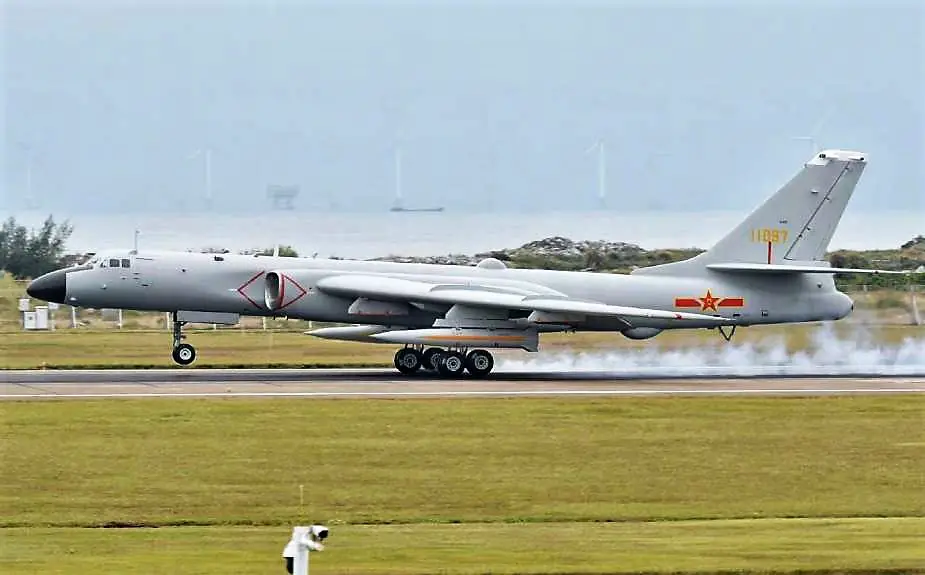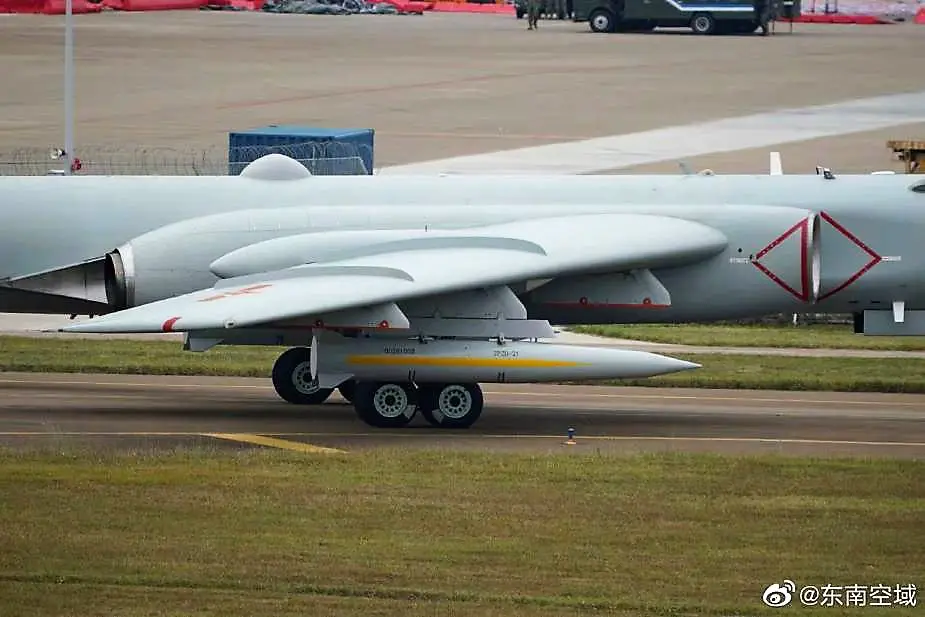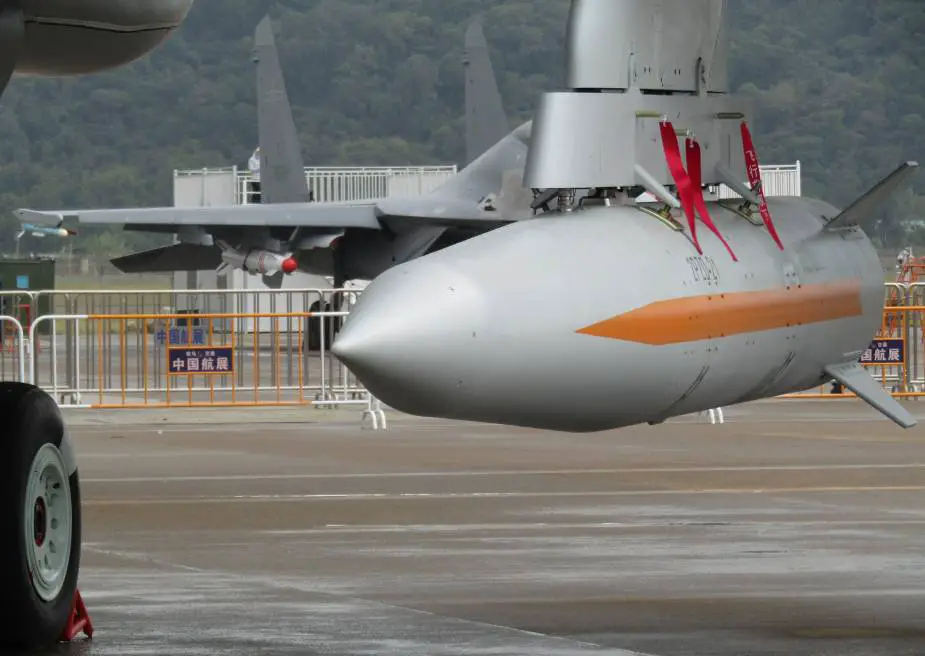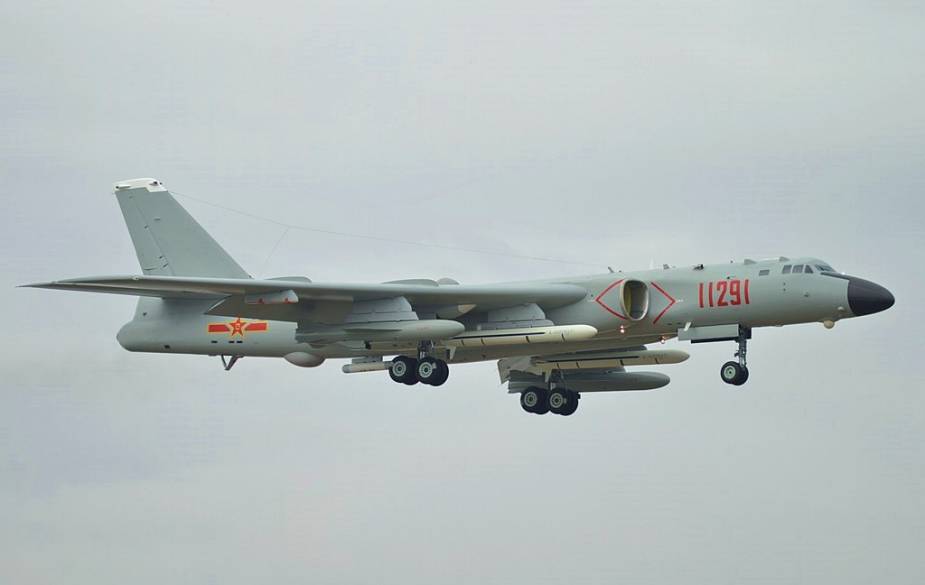At Zhuhai, China has unveiled a new air-launched ballistic missile (ALBM) to arm its People's Liberation Army Air Force's (PLAAF) Xi’an H-6K bomber fleet.
Follow Air Recognition on Google News at this link
 Two of the new missiles were carried by a Xi'an Aircraft Company (XAC) H-6K bomber, which arrived in Zhuhai, in South China's Guangdong Province, on 3 November for participating in Airshow China 2022. (Picture source: Weibo)
Two of the new missiles were carried by a Xi'an Aircraft Company (XAC) H-6K bomber, which arrived in Zhuhai, in South China's Guangdong Province, on 3 November for participating in Airshow China 2022. (Picture source: Weibo)
Two of the new missiles were carried by a Xi'an Aircraft Company (XAC) H-6K bomber, which arrived in Zhuhai, in South China's Guangdong Province, on 3 November for participating in Airshow China 2022 from 8 to 13 November.
As reported by Thomas Newdick in The War Zone and by other media, a new air-launched ballistic missile (ALBM) for Chinese Air Force’s Xi’an H-6K bombers has been spotted. While its origins are unconfirmed, the missile looks very similar to the CM-401, previously known as a truck- or ship-launched anti-ship ballistic missile (ASBM) that is also capable of hitting static land targets. According to Janes, the projectile is an air-launched hypersonic missile. The weapons system appears to be similar to the Russian Kh‐47M2 Kinzhal (AS-24 ‘Killjoy') ALBM. However, the new Chinese missile has a sleeker nose section, an aerodynamic body with a different control tailfins design, and a change in the position of the launching lugs.
China's air-launched anti-shipping capability is becoming a fundamental part of its wider and fast-evolving anti-access/area-denial (A2/AD) strategy, Thomas Newdick writes. But even if this is not intended to be an air-launched ASBM, or at least not in its first iterations, the ability to unleash the new ALBM on land targets is very concerning, as well.
The initial photos show H-6K serial number 11097 with a pair of the new missiles — which are presented in inert, form-factor-representative captive rounds — on the center pylons under its wings, arriving at the civilian Zhuhai Jinwan Airport for the Airshow China 2022 exhibition. This particular aircraft is assigned to the 8th Bomber Division of the Southern Theater Command, People’s Liberation Army Air Force (PLAAF). Missile-toting aircraft from this unit have also taken part in previous editions of Airshow China, Thomas Newdick reports.
 The new missile carried by a Xi'an Aircraft Company (XAC) H-6K bomber, which arrived in Zhuhai, in South China's Guangdong Province, on 3 November for participating in Airshow China 2022. (Picture source: Weibo)
The new missile carried by a Xi'an Aircraft Company (XAC) H-6K bomber, which arrived in Zhuhai, in South China's Guangdong Province, on 3 November for participating in Airshow China 2022. (Picture source: Weibo)
 The new missile carried by a Xi'an Aircraft Company (XAC) H-6K bomber (Picture source: Weibo)
The new missile carried by a Xi'an Aircraft Company (XAC) H-6K bomber (Picture source: Weibo)
H-6 (Hōng-6), a license-built version of the Soviet Tupolev Tu-16
The Xian H-6 (Hōng-6) is a license-built version of the Soviet Tupolev Tu-16 twin-engine jet bomber. Delivery of the Tu-16 to China began in 1958, and a license production agreement with the Soviets was signed in the late 1950s. Xi'an Aircraft Industrial Corporation (XAC) manufactured aircraft at Xi'an as the "H-6"; the first flew in 1959. By November 2020, the PLAAF had as many as 231. The latest variant of the H-6 is the H-6N, a heavily redesigned version capable of aerial refueling and carrying air-launched cruise missiles. According to the U.S. Department of Defense, this will give the PLAAF a long-range standoff offensive air capability with precision-guided munitions.
The first domestically produced H-6 was completed in 1968 and evidence of bombing training was recorded by U.S. spy satellites on August 13, 1971. By March 1972, the CIA estimated that China had 32 aircraft operational with an additional 19 awaiting completion. The H-6 was used to drop nine nuclear devices at the Lop Nur test site. However, with the increased development in ballistic missile technology, the nuclear delivery capabilities that the H-6 offered diminished in importance. The CIA estimated in 1976 that the H-6 had moved over to a dual nuclear/conventional bombing role.
 An XAC H-6K landing at Zhuhai Jinwan Airport with cruise missiles in 2018 (Picture source: Wikipedia/Alert5)
An XAC H-6K landing at Zhuhai Jinwan Airport with cruise missiles in 2018 (Picture source: Wikipedia/Alert5)
Xi’an H-6K bomber
The H-6K, first flying on January 5, 2007, entered service in October 2009 during the celebrations of the 60th anniversary of the People's Republic of China, and is claimed to make China the third country with an active strategic bomber after US and Russia. With a reinforced structure making use of composite materials, enlarged engine inlets for Russian Soloviev D-30 turbofan engines giving a claimed combat radius of 3,500 kilometres (2,200 mi), a glass cockpit with large size LCD multi-function display, and a reworked nose section eliminating the glazed navigator's station in favour of a more powerful radar, the H-6K is a significantly more modern aircraft than earlier versions. Six underwing hardpoints for CJ-10A cruise missiles are added. The rear 23 mm guns and gunner position are replaced by electronic components.
The H-6K is designed for long-range attacks and stand-off attacks. It is capable of attacking US carrier battle groups and priority targets in Asia. This aircraft has nuclear strike capability. While previous models had limited missile capacity (the H-6G could only carry two YJ-12 anti-ship missiles and the H-6M two KD-20/CJ-10K/CJ-20 land attack cruise missiles), the H-6K can carry up to six YJ-12 and 6-7 ALCMs; a single regiment of 18 H-6Ks fully loaded out with YJ-12s can saturate enemy ships with over 100 supersonic missiles. Although the aircraft has a new nose radome housing a modern air-to-ground radar, it is not clear if the bomber or other Chinese assets yet have the capability to collect accurate targeting information for successful strikes against point targets in areas beyond the first island chain. An electro-optical targeting system is fitted under the nose.
The WS-18 (or WS-18A) engine may be intended to re-engine the H-6K. The WS-18 - a copy or derivative of the D-30 - began development in 2007 and flight testing in 2015.
In 2015, about 15 H-6Ks were in service. A H-6K fitted with a refuelling probe may have first flown in December 2016. Besides extending range, a possible mission for the variant may be to launch satellites or ballistic missiles.
Defense Intelligence Agency chief Ashley confirmed that China is developing two new air-launched ballistic missiles, (CH-AS-X-13) one of which can carry a nuclear warhead. The H-6K would be suited to launch such missiles, which would appear demonstrated at Airshow China 2022 in Zhuhai.
In January 2019, Norinco announced it had tested an analog of the American "Mother of all Bombs." The weapon is carried by an H-6K and takes up the whole of the bomb bay, making it roughly 5–6 m (16–20 ft) long and weighing 10 tons. Chinese media claimed it could be used for wiping out reinforced buildings and shelters as well as clearing obstacles to create an aircraft landing zone.
In October 2022, Chinese media showcased the prospective concepts of H-6K carrying LJ-1 unmanned aerial system conducting drone swarm tactics. LJ-1 was originally designed as a target practice drone with a modular payload, which could be modified into a decoy or electronic warfare platform.
.
















